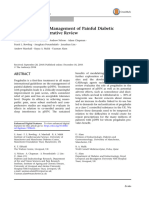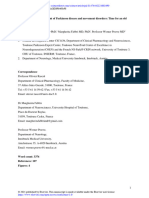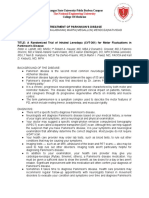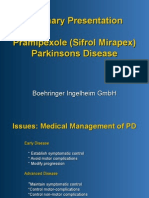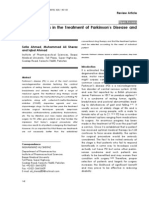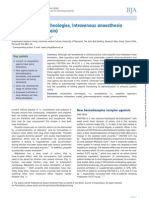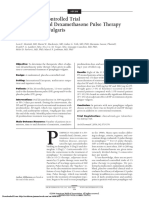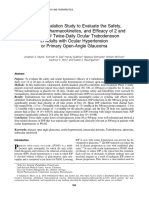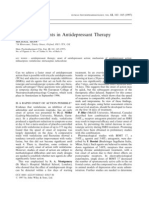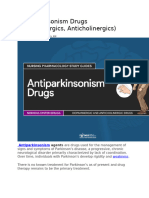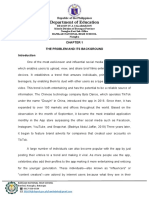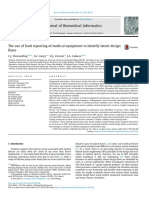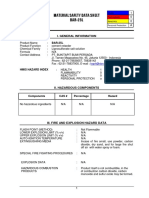Jurnal Parkinson Oni
Jurnal Parkinson Oni
Uploaded by
Muhammad Agung SwasonoCopyright:
Available Formats
Jurnal Parkinson Oni
Jurnal Parkinson Oni
Uploaded by
Muhammad Agung SwasonoCopyright
Available Formats
Share this document
Did you find this document useful?
Is this content inappropriate?
Copyright:
Available Formats
Jurnal Parkinson Oni
Jurnal Parkinson Oni
Uploaded by
Muhammad Agung SwasonoCopyright:
Available Formats
CARLOS SINGER, MD
Professor of Neurology, Chief, Center for Parkinsons Disease
and Movement Disorders, Leonard M. Miller School of Medicine,
University of Miami, Miami, FL
Managing the patient with newly diagnosed
Parkinson disease
ABSTRACT
The treatment of early Parkinson disease (PD) is generally
symptomatic, although therapy that also offers neuroprotection in early-stage PD would be welcomed. Levodopa remains the most effective agent for relief of PD
symptoms, but chronic levodopa therapy is associated
with motor fluctuations and dyskinesias, and clinicians
may therefore opt to postpone its use. Alternatives to
levodopa in early PD include monoamine oxidase (MAO)-B
inhibitors, amantadine, and dopamine agonists. MAO-B
inhibitors have only mild symptomatic effects. Amantadine
is associated with improvement in functional disability
and, in a subset of PD patients, a robust symptomatic
improvement. Dopamine agonists improve symptoms and
may have a neuroprotective effect. Partial dopamine agonists, adenosine A2A-receptor antagonists, and safinamide
are symptomatic therapies that are under investigation.
Neuroprotective strategies under study include enhancement of mitochondrial function, antiinflammatory
mechanisms, calcium channel blockade, and uric acid
elevation. Deep brain stimulation may slow cognitive and
motor decline when used in early PD. Stem cell therapy
and gene therapy are still under investigation.
arkinson disease (PD) is a slowly progressive
neurodegenerative disorder. Early PD, or stage 1
or 2 on the Unified Parkinsons Disease Rating
Scale (UPDRS), is characterized by mild symptoms, minimal to mild disability, and lack of postural
instability or cognitive decline. The goal of therapy in
PD is to help patients retain functional independence
for as long as possible. Therapeutic choices in early
PD are guided by the effect of symptoms on function
Dr. Singer reported receiving grant support from Boehringer Ingelheim and
Teva Pharmaceuticals, Inc.; and advisory committee or review panel membership for Lundbeck.
This article is based on Dr. Singers presentation at The Annual Therapy Symposium on Movement Disorders for the Modern Clinician held in Fort Lauderdale, Florida, on January 29, 2011. The article was drafted by Cleveland Clinic
Journal of Medicine staff and was then reviewed, revised, and approved by
Dr. Singer.
doi:10.3949/ccjm.79.s2a.01
and quality of life, consideration of complications
associated with long-term levodopa, the likelihood of
response fluctuations to levodopa, and the potential for
a neuroprotective effect.
SYMPTOMATIC THERAPIES IN EARLY PD
Dopaminergic replacement therapy with levodopa is a
legitimate choice for the treatment of early PD. Use of
carbidopa-levodopa has been shown to slow the progression of PD in a dose-dependent manner as evidenced
by a decrease in total score on the UPDRS in patients
with early PD who were randomly assigned to receive
carbidopa-levodopa compared with those who received
a placebo.1
Alternatives to levodopa
There are several reasons to choose an alternative to
levodopa for the treatment of early PD. The first is to
postpone the development of levodopa-induced dyskinesias, which are linked to duration of levodopa treatment
and total exposure to levodopa. The second is postponement of the wearing-off effect; that is, the reemergence
of symptoms that occurs in some patients before their
next scheduled dose of levodopa. Such reasoning applies
to early PD patients with minimal or no disability and
in particularto young-onset PD patients who tend to
develop vigorous dyskinesias and dramatic wearing-off
phenomena. Pharmacologic alternatives to levodopa in
early PD include monoamine oxidase (MAO)-B inhibitors, amantadine, and dopamine agonists.
MAO-B inhibitors. Two MAO-B inhibitors are
approved by the US Food and Drug Administration for
the treatment of PD: rasagiline and selegiline. These
agents have a mildly symptomatic effect. In the Attenuation of Disease Progression with Azilect Given Oncedaily (ADAGIO) trial, use of rasagiline at doses of 1
and 2 mg/d slowed the rate of worsening of the UPDRS
score compared with placebo in patients with untreated
PD (Figure 1).2 Patients were randomly assigned to an
early-start group (rasagiline, 1 or 2 mg/d, or placebo for
72 weeks) or a late-start group (placebo for 36 weeks
followed by rasagiline, 1 or 2 mg/d, or placebo for 36
weeks). The rate of change in the UPDRS score was
CLEVELAND CLINIC JOURNAL OF MEDICINE
VO L U M E 7 9 S U P P L E M E N T 2
Downloaded from www.ccjm.org on November 21, 2014. For personal use only. All other uses require permission.
J U LY 2 0 1 2
S3
EARLY PARKINSON DISEASE
Amantadine. In an early study of 54
patients with PD, functional disability
scores improved significantly with administration of amantadine 200 to 300 mg/d
5
compared with placebo.4 A small subset
Delayed-start
4
of
patients, perhaps 20% or less, who
(placebo-rasagiline)
are
treated with amantadine experience
3
robust
symptom improvement. Side effects
of
amantadine
include hallucinations,
edema, livedo reticularis, and anticholin1
ergic effects. A more recently discovered
0
potential side effect is corneal edema.
1
Dopamine agonists. Pramipexole (immeEarly-start
(rasagiline-rasagiline)
diate-release
[IR] and extended-release
2
[ER]), and ropinirole IR and ER are dopa3
mine agonists that have demonstrated
0
36 42 48 54 60 66 72
12
24
disease-modifying effects and efficacy in
Week
improving PD symptoms.
Baseline
Pramipexole ER administered once daily
in early PD was shown to be superior to
B
placebo on the mean UPDRS total score.5
5
Ropinirole ER produced mean plasma concentrations over 24 hours similar to those
4
Delayed-start
achieved with ropinirole IR, and showed
(placebo-rasagiline)
3
noninferiority to ropinirole IR on efficacy
2
measures in patients with de novo PD.5
The effective dosage range of pramipex1
ole ER in early PD is 0.375 to 4.5 mg/d.
0
Side effects include hallucinations, edema,
Early-start
excessive diurnal somnolence, and impulse
1
(rasagiline-rasagiline)
control disorders (ie, pathologic gambling,
2
hypersexuality, excessive craving for
sweets). Compared with pramipexole IR,
3
0
36 42 48 54 60 66 72
12
24
compliance is enhanced with the ER forWeek
mulation because of ease of administration,
Baseline
but this formulation also is more expensive.
In early PD, the effective dosage range
FIGURE 1. Rasagiline at doses of 1 mg/day (A) and 2 mg/day (B) slowed the rate
of ropinirole ER is 8 to 12 mg/d.6 The side
of worsening of the Unified Parkinsons Disease Rating Scale (UPDRS) score compared
effects are the same as with pramipexole
with placebo in patients with untreated Parkinson disease.2
ER with the same compliance advantage
Reprinted with permission from The New England Journal of Medicine (Olanow CW, et al. A double-blind,
and cost disadvantage compared with the
delayed-start trial of rasagiline in Parkinsons disease. N Engl J Med 2009; 361:12681278).
Copyright 2009 Massachusetts Medical Society. All rights reserved.
IR formulation.
Research indicates that dopamine agonists may have a neuroprotective effect. In two large
slowed significantly with early treatment with rasagiline
clinical trials in which patients with PD were followed
at a dosage of 1 mg/d, but not at 2 mg/d. Because the
with an imaging marker of dopamine neuronal degenhierarchical primary end points for the ADAGIO trial
eration (using single-photon emission computed tomogwere met only for the cohort receiving 1 mg of rasagiline
raphy or positron emission tomography), recipients of
early, it remains inconclusive whether rasagiline has a
pramipexole7 or ropinirole8 showed slower neuronal
neuroprotective effect.
deterioration compared with levodopa recipients. A
In a placebo-controlled study of selegiline in de novo
counterargument to the neuroprotective theory is that
early-phase PD, Plhagen et al showed that selegiline
these differences between the dopamine agonists and
monotherapy delayed the need for levodopa. When
levodopa reflect neurotoxicity of levodopa rather than
used in combination with levodopa, selegiline was able
neuroprotection by dopamine agonists. The absence of
to slow the progression of PD as measured by the change
a placebo comparison in both trials adds to the difficulty
in UPDRS total score.3
S4
Mean change in UPDRS score (points)
Mean change in UPDRS score (points)
Improvement
Worsening
Improvement
Worsening
CLEVELAND CLINIC JOURNAL OF MEDICINE
VO L U M E 7 9 S U P P L E M E N T 2
J U LY 2 0 1 2
Downloaded from www.ccjm.org on November 21, 2014. For personal use only. All other uses require permission.
SINGER
in drawing a conclusion, as some critics ascribed the
differences between groups to downregulation of tracer
binding with levodopa.
Nonergoline dopamine agonist. Transdermal rotigotine is a nonergot D1/D2/D3 agonist. Higher doses produce higher plasma levels of rotigotine, which remain
steady over the 24-hour dosing interval.9 Transdermal
rotigotine has demonstrated effectiveness in early PD in
several clinical trials.10,11 The patch, applied once daily,
provides a constant release of medication. Removing
the patch immediately interrupts drug administration.
Rotigotine patches must be refrigerated to prevent
crystallization, a requirement that has delayed the
products arrival on the market. The patch is reputed
to be difficult to peel from its backing and apply. Skin
reactions are a side effect, and nonergot side effects are
possible. Despite these drawbacks, transdermal rotigotine represents a convenient option for perioperative
management of PD and in patients with dysphagia.
Exercise. Exercise has symptomatic and possibly
neuroprotective benefits in PD, supporting its use as
an additional medical measure. Evidence supports the
value of treadmill walking and high-impact exercise
in improving stride length, quality of life, and motor
response to levodopa.
SYMPTOMATIC THERAPIES: THE FUTURE
Partial dopamine agonists
Pardoprunox is a partial dopamine agonist with full
5-HT1Aagonist activity. A partial dopamine agonist
acts in two ways: (1) It stimulates dopamine production
in brain regions with low dopamine tone, and (2) it
has dopamine antagonist activity under circumstances
of high dopamine sensitivity, theoretically avoiding
overstimulation of dopamine receptors. Because it
inhibits excessive dopamine effect, pardoprunox may
prevent dyskinesia. In addition, because pardoprunox
has serotonin agonist activity, it may also act as an
antidepressant.
In a phase 2 study, significantly more patients randomized to pardoprunox had a 30% or greater reduction
in UPDRS motor score compared with placebo at endof-dose titration (35.8% for pardoprunox vs 15.7% for
placebo; P = .0065) and at end point (50.7% for pardoprunox vs 15.7% for placebo; P < .0001).12
Adenosine A2A-receptor antagonists
Adenosine A2A receptors are located in the basal ganglia, primarily on gamma aminobutyric acid (GABA)
mediated enkephalin-expressing medium spiny neurons
in the striatum. These receptors modulate dopamine
transmission by opposing D2-receptor activity. The D2
pathway is an indirect pathway that promotes suppression of unnecessary movement.
Two A2A-receptor antagonists have demonstrated
efficacy in clinical trials. Vipadenant has been proven
effective as monotherapy in phase 2 clinical trials. Preladenant has been shown to improve off time as an
adjunct to levodopa without increasing dyskinesia.
Safinamide
Safinamide, currently in phase 3 clinical trials, has three
mechanisms of action. It is an inhibitor of dopamine
reuptake, a reversible inhibitor of MAO-B, and an
inhibitor of excessive glutamate release. The addition of
safinamide to a stable dose of a single dopamine agonist
in patients with early PD resulted in improvement of
motor symptoms and cognitive function.13,14
NEUROPROTECTIVE STRATEGIES
UNDER INVESTIGATION
Four neuroprotective strategies are under study: enhanced
mitochondrial function, antiinflammatory mechanisms,
calcium channel blockade, and uric acid elevation.
Enhanced mitochondrial function
Creatine has generated interest as a disease-modifying
agent in response to preclinical data showing that it
could enhance mitochondrial function and prevent
mitochondrial loss in the brain in models of PD. Creatine is now the subject of a large phase 3 National
Institutes of Healthsponsored clinical trial in patients
with early-stage PD.15
Coenzyme Q10 (CoQ 10) exhibited a trend for neuroprotection at 1,200 mg/d, lowering the total mean UPDRS
score compared with placebo in a 16-month study.16 Current efforts are directed at determining whether 1,200 or
2,400 mg/d of CoQ10 are neuroprotective. A nanoparticulate form of CoQ10, 100 mg three times a day, has been
shown to produce plasma levels of CoQ10 equivalent to
those produced by 1,200-mg doses of the standard form.17
CoQ10 is free of symptomatic effects.
Antiinflammatory mechanisms
Parkinson disease may have an important inflammatory
component. A meta-analysis of seven studies showed an
overall hazard ratio of 0.85 for development of PD in
users of nonaspirin nonsteroidal antiinflammatory drugs
(NSAIDs), with each of the seven studies demonstrating a hazard ratio less than 1.18 A similar meta-analysis
showed no such association.19 Further study is warranted.
The antidiabetic agent pioglitazone, shown in mice to
prevent dopaminergic nigral cell loss, has been entered
into a phase 2 clinical trial to assess its antiinflammatory
properties in PD.
Calcium channel blockade
A sustained-release formulation of isradipine, an L-type
calcium channel blocker, is being studied in a phase 2
CLEVELAND CLINIC JOURNAL OF MEDICINE
VO L U M E 7 9 S U P P L E M E N T 2
Downloaded from www.ccjm.org on November 21, 2014. For personal use only. All other uses require permission.
J U LY 2 0 1 2
S5
EARLY PARKINSON DISEASE
Quality-adjusted
life expectancy
26
24
22
20
18
16
14 Base case
12
10
0
0.1
Early STN DBS
Delayed STN DBS
0.2
0.3
0.4
0.5
Annual rate of progression of motor decline (per year)
Quality-adjusted
life expectancy
26
24
22
20
18
16
14 Base case
12
10
0
0.1
Threshold
0.2
0.3
0.4
0.5
Annual rate of progression of motor decline (per year)
FIGURE 2. In a comparison of early versus late subthalamic nucleus
deep brain stimulation (STN DBS), the annual rate of progression of
both cognitive (A) and motor (B) decline was slower when STN DBS
was administered earlier in the course of Parkinson disease (PD).
Late STN DBS is favored if the annual rate of motor progression is
greater than 25%, but this is an unrealistic scenario for PD.21
Reprinted with permission from Movement Disorders (Espay AJ, et al.
Early versus delayed bilateral subthalamic deep brain stimulation for
Parkinsons disease: a decision analysis. Mov Disord 2010; 25:14561463).
Copyright 2010 Movement Disorder Society.
clinical trial for the treatment of early PD; experimental
evidence in animals suggests that it may be neuroprotective against PD.
Uric acid elevation
Urate concentration in the cerebrospinal fluid predicts
progression of PD, with higher levels associated with
slower progression of disease.20 Urate may delay oxidative destruction of dopaminergic neurons that occurs
with progression of PD. Pharmacologic elevation of uric
acid is being explored as a treatment option in PD.
ELECTRODES, VECTORS, AND STEM CELLS
Deep brain stimulation
Deep brain stimulation (DBS) is currently used as a treatment for advanced PD (patients suffering from levodopainduced motor complications), but it might also slow
the progression of cognitive and motor decline in earlier
stages of PD. The annual rate of progression of both cognitive and motor decline was slower when DBS was administered earlier in the course of PD (off time on levodopa
of about 2 hours) versus in a later stage of PD (off time on
levodopa of about 4 hours) (Figure 2).21 The strategy is
being tested further in clinical trials of early PD.
S6
CLEVELAND CLINIC JOURNAL OF MEDICINE
Stem cell therapy
Stem cells obtained from blastocytes, fibroblasts, bone
marrow, or the adult, embryonic, or fetal central nervous system through molecular alchemy can form
dopaminergic neuroblasts. Given the high cost and
potential risks of stem cell therapy, it must be proven
superior to DBS to be considered an option for early PD.
Several practical problems act as hurdles to successful
stem cell therapy. Efficient generation of dopamineproducing neurons and successful grafting are required.
Tumor growth is a risk. Involuntary movements have
been observed in some patients who received fetal
implants. A limitation of stem cell therapy is that it will
only affect those aspects of PD that are dependent on
dopamine.
Gene therapy
Gene delivery of the growth factor analogue adenoassociated type-2 vector (AAV2)-neurturin has been
investigated in patients with advanced PD. When surgically placed inside a neuron, neurturin enhances neuron
vitality, enabling it to better fight oxidative stress and
other attacks. It fared no better than sham surgery on
changes in UPDRS motor score at 12 months in a randomized trial.22 A few patients enrolled in this trial have
been followed for longer than 12 months, at which time
the mean change in motor scores appears to favor the
group assigned to gene delivery of AAV2-neurturin. A
phase 1/2 trial is investigating the safety and efficacy of
bilateral intraputaminal and intranigral administration
of neurturin.
SUMMARY
Levodopa is a legitimate choice for the treatment of
early PD. Two MAO-B inhibitors, rasagiline and selegiline, have a symptomatic effect.
Long-acting oral and transdermal dopamine agonists
are effective symptomatic therapies, but they also have
an interesting array of side effects, making levodopa a
reasonable alternative treatment sooner or later despite
its dyskinetic effect. Potential neuroprotective effects
remain to be identified.
Amantadine is sometimes overlooked as an option
for treating early PD, but it has some special side effects
including leg edema, livedo reticularis, and corneal
edema. Amantadine does not cause orthostatic hypotension and is free of the side effects of excessive diurnal somnolence and impulse control disorders that are
prevalent with dopamine agonists.
In the future, partial dopamine agonists and adenosine
antagonists may provide us with additional symptomatic
therapies. CoQ10, creatine, calcium channel blockers,
and inosine, as well as NSAIDs, are being actively studied as potential disease-modifying agents. Further studies are likely to come from the use of NSAIDs.
VO L U M E 7 9 S U P P L E M E N T 2
J U LY 2 0 1 2
Downloaded from www.ccjm.org on November 21, 2014. For personal use only. All other uses require permission.
SINGER
Early DBS is a new avenue of investigation as a
potential disease modifier. Stem cells are still being
studied and limitations of sufficient production and
potential tumor growth, among others, have delayed the
institution of clinical trials. Gene therapy is an interesting additional treatment modality in active research.
REFERENCES
1. Fahn S, Oakes D, Shoulson I, et al. Levodopa and the progression
of Parkinsons disease. N Engl J Med 2004; 351:24982508.
2. Olanow CW, Rascol O, Hauser R, et al. A double-blind, delayedstart trial of rasagiline in Parkinsons disease. N Engl J Med 2009;
361:12681278.
3. Plhagen S, Heinonen E, Hgglund J, et al. Selegiline slows the
progression of the symptoms of Parkinson disease. Neurology 2006;
66:12001206.
4. Barbeau A, Mars H, Botez MI, Joubert M. Amantadine-HCl
(Symmetrel) in the management of Parkinsons disease: a doubleblind cross-over study. Can Med Assoc J 1971; 105:4246.
5. Hauser RA, Schapira AH, Rascol O, et al. Randomized, doubleblind, multicenter evaluation of pramipexole extended release once
daily in early Parkinsons disease. Mov Disord 2010; 25:25422549.
6. Onofrj M, Bonanni L, De Angelis MV, Anzellotti F, Ciccocioppo F,
Thomas A. Long half-life and prolonged-release dopamine receptor
antagonists: a review of ropinirole prolonged-release studies. Parkinsonism Relat Disord 2009; 15(suppl 4):S85S92.
7. Parkinson Study Group. Dopamine transporter brain imaging to
assess the effects of pramipexole vs levodopa on Parkinson disease
progression. JAMA 2002; 287:16531661.
8. Whone AL, Watts RL, Stoessl AJ, et al. Slower progression of
Parkinsons disease with ropinirole versus levodopa: the REAL-PET
study. Ann Neurol 2003; 54:93101.
9. Reichmann H. Transdermal delivery of dopamine receptor agonists.
Parkinsonism Relat Disord 2009; 15(suppl 4):S93S96.
10. Parkinson Study Group. A controlled trial of rotigotine monotherapy in early Parkinsons disease. Arch Neurol 2003; 60:17211728.
11. Watts RL, Jankovic J, Waters C et al. Randomized, blind, controlled trial of transdermal rotigotine in early Parkinson disease.
Neurology 2007; 68: 272276.
12. Bronzova J, Sampaio C, Hauser RA, et al. Double-blind study of
pardoprunox, a new partial dopamine agonist, in early Parkinsons
disease. Mov Disord 2010; 25:738746.
13. Stocchi F, Arnold G, Onofrj M, et al; Safinamide Parkinsons
Study Group. Improvement of motor function in early Parkinson
disease by safinamide. Neurology 2004; 63:746748.
14. Schapira AHV. Safinamide in the treatment of Parkinsons disease.
Expert Opin Pharmacother 2010; 11:22612268.
15. NINDS NET-PD Investigators. A randomized, double-blind,
futility clinical trial of creatine and minocycline in early Parkinson
disease. Neurology 2006; 66:664671.
16. Shults CW, Oakes D, Kieburtz K; and the Parkinson Study
Group. Effects of coenzyme q10 in early Parkinson disease: evidence of slowing of the functional decline. Arch Neurol 2002;
59:15411550.
17. Storch A, Jost W, Vieregge P, et al. Randomized, double-blind,
placebo-controlled trial on symptomatic effects of coenzyme q(10)
in Parkinson disease. Arch Neurol 2007; 64:938944.
18. Gagne JJ, Power MC. Anti-inflammatory drugs and risk of Parkinson disease: a meta-analysis. Neurology 2010; 74:9951002.
19. Samii A, Etminan M, Wiens MO, Jafari S. NSAID use and the
risk of Parkinsons disease: systematic review and meta-analysis of
observational studies. Drugs Aging 2009; 26:769779.
20. Ascherio A, LeWitt PA, Xu K, et al; Parkinson Study Group
DATATOP Investigators. Urate as a predictor of the rate of clinical decline in Parkinson disease. Arch Neurol 2009; 66:14601468.
21. Espay AJ, Vaughan JE, Marras C, Fowler R, Eckman MH.
Early versus delayed bilateral subthalamic deep brain stimulation
for Parkinsons disease: a decision analysis. Mov Disord 2010;
25:14561463.
22. Marks WJ Jr, Bartus RT, Siffert J, et al. Gene delivery of AAV2neurturin for Parkinsons disease: a double-blind, randomised, controlled trial. Lancet Neur 2010; 9:11641172.
Correspondence: Carlos Singer, MD, Center for Parkinsons Disease and
Movement Disorders, Clinical Research Building, Leonard M. Miller School
of Medicine, University of Miami, 1120 NW 14th Street, 13th Floor, Miami, FL
33136; CSinger@med.miami.edu
CLEVELAND CLINIC JOURNAL OF MEDICINE
VO L U M E 7 9 S U P P L E M E N T 2
Downloaded from www.ccjm.org on November 21, 2014. For personal use only. All other uses require permission.
J U LY 2 0 1 2
S7
You might also like
- Ronald D. Siegel - The Extraordinary Gift of Being Ordinary - Finding Happiness Right Where You Are-The Guilford Presd (2022)Document307 pagesRonald D. Siegel - The Extraordinary Gift of Being Ordinary - Finding Happiness Right Where You Are-The Guilford Presd (2022)milenalucic0No ratings yet
- Planetary Apothecary - An Astrological Approach To Health and WellnessDocument217 pagesPlanetary Apothecary - An Astrological Approach To Health and Wellnessankita goswami89% (9)
- NDT 5190 Therapeutic Interventions and Adjustments in The Management 072910Document8 pagesNDT 5190 Therapeutic Interventions and Adjustments in The Management 072910MatejNo ratings yet
- Jurnal 1 PDFDocument10 pagesJurnal 1 PDFTamii Unyu Unyuna JBNo ratings yet
- Initial Pharmacologic Treatment of Parkinson Disease - UpToDateDocument23 pagesInitial Pharmacologic Treatment of Parkinson Disease - UpToDatelenushpopaNo ratings yet
- Update On The Use of Pramipexole in The Treatment of Parkinson's DiseaseDocument16 pagesUpdate On The Use of Pramipexole in The Treatment of Parkinson's DiseaseDiego Marcelo Aragon CaqueoNo ratings yet
- PD Treatment Adverse EventsDocument19 pagesPD Treatment Adverse EventsAshok Kumar KrishnamoorthyNo ratings yet
- Treatment ParkinsonDocument3 pagesTreatment ParkinsonElisabethNo ratings yet
- INTRODUCTION - The Array of Pharmacologic and Surgical Treatments Available For TheDocument4 pagesINTRODUCTION - The Array of Pharmacologic and Surgical Treatments Available For TheKidu GideyNo ratings yet
- Comment: Lancet Neurol 2020Document2 pagesComment: Lancet Neurol 2020dhea nadhiaNo ratings yet
- Dopamine Agonists: Barrow Neurological Institute, Phoenix, Arizona, U.S.ADocument17 pagesDopamine Agonists: Barrow Neurological Institute, Phoenix, Arizona, U.S.Aelenac67No ratings yet
- Initial Pharmacologic Treatment of Parkinson Disease - UpToDateDocument36 pagesInitial Pharmacologic Treatment of Parkinson Disease - UpToDateMaimuna MarshedNo ratings yet
- Drug Therapy For Parkinson's DiseaseDocument9 pagesDrug Therapy For Parkinson's DiseaseDireccion Medica EJENo ratings yet
- The Use of Amantadine HCL in Clinical Practice: A Study of Old and New IndicationsDocument6 pagesThe Use of Amantadine HCL in Clinical Practice: A Study of Old and New IndicationsSartika Rizky HapsariNo ratings yet
- Parkinson DiseaseDocument46 pagesParkinson DiseaseMohammed Waleed Al HgafariNo ratings yet
- Pregabalin in The Management of Painful DiabeticDocument22 pagesPregabalin in The Management of Painful DiabeticAzka SamalNo ratings yet
- Aripiprazol Discinecias Por LdopaDocument4 pagesAripiprazol Discinecias Por LdopaHercaiNo ratings yet
- parkinson's therapy nature reviewDocument13 pagesparkinson's therapy nature reviewpeiheng.zhangNo ratings yet
- Management of Parkinson's DiseaseDocument20 pagesManagement of Parkinson's DiseasePia S.No ratings yet
- Modafinil and Armodafinil in Schizophrenia: Chittaranjan Andrade, MDDocument3 pagesModafinil and Armodafinil in Schizophrenia: Chittaranjan Andrade, MDbenedicte lewinNo ratings yet
- SR - đau do tiểu đường - MirogabapentinDocument47 pagesSR - đau do tiểu đường - MirogabapentinMai Linh Le ThiNo ratings yet
- 1-s2.0-S1474442221002490-amDocument24 pages1-s2.0-S1474442221002490-amNhư Bùi Lê QuỳnhNo ratings yet
- JOURNALDocument10 pagesJOURNALTin NatividadNo ratings yet
- Summary Sifrol FarmakologiDocument38 pagesSummary Sifrol FarmakologiRadityaRezhaNo ratings yet
- NuitDocument12 pagesNuitPrasetiyo WilliamNo ratings yet
- 142JMSDocument11 pages142JMSLianylin Calinao VargasNo ratings yet
- Parkinsons Disease Prescribing Guidelines 2019 JMB Master 003 1615205551Document18 pagesParkinsons Disease Prescribing Guidelines 2019 JMB Master 003 1615205551143 lutfiana azzahraNo ratings yet
- The Role of Dopamine Agonist Extended Release in Early and Late PDDocument60 pagesThe Role of Dopamine Agonist Extended Release in Early and Late PDfahlevyNo ratings yet
- TBL XV W5Document17 pagesTBL XV W5pharmddoctor7No ratings yet
- Guideline Watch: Practice Guideline For The Treatment of Patients With Bipolar Disorder, 2Nd EditionDocument9 pagesGuideline Watch: Practice Guideline For The Treatment of Patients With Bipolar Disorder, 2Nd EditionstefensamuelNo ratings yet
- Guideline Watch: Practice Guideline For The Treatment of Patients With Bipolar Disorder, 2Nd EditionDocument9 pagesGuideline Watch: Practice Guideline For The Treatment of Patients With Bipolar Disorder, 2Nd Editionrocsa11No ratings yet
- Research Article: Very Low-Dose Risperidone in First-Episode Psychosis: A Safe and Effective Way To Initiate TreatmentDocument11 pagesResearch Article: Very Low-Dose Risperidone in First-Episode Psychosis: A Safe and Effective Way To Initiate Treatmentnaufal12345No ratings yet
- PropofolDocument9 pagesPropofolarturschander3614No ratings yet
- Parkinson's Disease: Neurovascular DisordersDocument24 pagesParkinson's Disease: Neurovascular DisordersNdoo NdooNo ratings yet
- Motor FluctuationDocument9 pagesMotor FluctuationA5BNi Gusti Ketut Purnami Putri AdnyaniNo ratings yet
- Alzehmers DiseaseDocument53 pagesAlzehmers DiseaseAwais Arain AhmadNo ratings yet
- PGN Unit 2b CNS UDocument25 pagesPGN Unit 2b CNS Ulea.j.sfeirNo ratings yet
- MiutoDocument12 pagesMiutoPrasetiyo WilliamNo ratings yet
- The Effect of Pramipexole On Depressive Symptoms in Parkinson's DiseaseDocument6 pagesThe Effect of Pramipexole On Depressive Symptoms in Parkinson's DiseaseCarmen CiursaşNo ratings yet
- Alpha-Dihydroergocryptine vs. Pramipexole As Adjunct Symptomatic Treatment of Idiopathic Parkinson'sDocument9 pagesAlpha-Dihydroergocryptine vs. Pramipexole As Adjunct Symptomatic Treatment of Idiopathic Parkinson'sRizka Leonita FahmyNo ratings yet
- dst50234 PDFDocument7 pagesdst50234 PDFtaniaNo ratings yet
- Clayton May 2023Document9 pagesClayton May 2023ahmadnawaz420No ratings yet
- Obat GlaukomaDocument8 pagesObat GlaukomaMuhammad Farrash HadyanNo ratings yet
- Mirapex: 0.125 MG, 0.25 MG, 0.5 MG, 1 MG, and 1.5 MG TabletsDocument32 pagesMirapex: 0.125 MG, 0.25 MG, 0.5 MG, 1 MG, and 1.5 MG TabletsAnggunNo ratings yet
- 415 2018 Article 8886Document2 pages415 2018 Article 8886lathifatulNo ratings yet
- Is Pramipexole Safe and Effective in Reducing Depressive SymptomsDocument15 pagesIs Pramipexole Safe and Effective in Reducing Depressive SymptomsvgargcnbNo ratings yet
- Comparison of Once-Daily Versus Twice-Daily Combination of Ropinirole Prolonged Release in Parkinson 'S DiseaseDocument7 pagesComparison of Once-Daily Versus Twice-Daily Combination of Ropinirole Prolonged Release in Parkinson 'S DiseaseAlfiatur RizkiNo ratings yet
- MkioutDocument12 pagesMkioutPrasetiyo WilliamNo ratings yet
- Tramadol Pregabalin InteractionDocument9 pagesTramadol Pregabalin InteractionnicolaslolxNo ratings yet
- Diabetes Obesity Metabolism - 2023 - Eissing - Pharmacokinetics and Pharmacodynamics of Finerenone in Patients With ChronicDocument13 pagesDiabetes Obesity Metabolism - 2023 - Eissing - Pharmacokinetics and Pharmacodynamics of Finerenone in Patients With ChronicDandung RuskarNo ratings yet
- Neuropharmacology: Danielle Larson, Tanya SimuniDocument6 pagesNeuropharmacology: Danielle Larson, Tanya SimunigustavoNo ratings yet
- Maintenance of Heartburn Relief After Step-Down From Twice-Daily Proton Pump Inhibitor To Once-Daily Dexlansoprazole Modified ReleaseDocument7 pagesMaintenance of Heartburn Relief After Step-Down From Twice-Daily Proton Pump Inhibitor To Once-Daily Dexlansoprazole Modified ReleaseAugusto BritoNo ratings yet
- Efficacy and Safety of Aripiprazole in Child and Adolescent Patients (2012)Document8 pagesEfficacy and Safety of Aripiprazole in Child and Adolescent Patients (2012)Jose VilelaNo ratings yet
- New Developments in Antidepressant TherapyDocument5 pagesNew Developments in Antidepressant TherapyDoyin AwodeleNo ratings yet
- 10-Antiparkinsonian and Spasmolytic AgentsDocument32 pages10-Antiparkinsonian and Spasmolytic Agentszeynep özdalNo ratings yet
- 3.current Pharmaceutical Treatments and Alternative Therapies ofDocument17 pages3.current Pharmaceutical Treatments and Alternative Therapies ofPaula Betancor MontesdeocaNo ratings yet
- Brexpiprazole: A Review of A New Treatment Option For Schizophrenia and Major Depressive DisorderDocument6 pagesBrexpiprazole: A Review of A New Treatment Option For Schizophrenia and Major Depressive DisorderLuis Pablo HsNo ratings yet
- Antiparkinsonism DrugsDocument12 pagesAntiparkinsonism Drugsabushatemesgen2127No ratings yet
- Seizure MedicationsDocument3 pagesSeizure Medicationsm.dhiyarahadianNo ratings yet
- NjiutDocument12 pagesNjiutPrasetiyo WilliamNo ratings yet
- Koiu MMDocument12 pagesKoiu MMPrasetiyo WilliamNo ratings yet
- Fast Facts: Ottimizzazione del trattamento delle fluttuazioni motorie nella malattia di ParkinsonFrom EverandFast Facts: Ottimizzazione del trattamento delle fluttuazioni motorie nella malattia di ParkinsonNo ratings yet
- Name of Patient: Agency/ Area: Diagnosis: Rating: - Assessment Subjective Objective Anxious C Body Weakness Uneasy UncomfortableDocument3 pagesName of Patient: Agency/ Area: Diagnosis: Rating: - Assessment Subjective Objective Anxious C Body Weakness Uneasy UncomfortableNicoAsiñeroNo ratings yet
- Chapter 1 5 Tins GroupDocument25 pagesChapter 1 5 Tins GroupChristian Jay VillafrancaNo ratings yet
- To Prank Reviewer MergedDocument530 pagesTo Prank Reviewer MergedMylene Grace ElarcosaNo ratings yet
- HEALTH REAC 4 Physicians by CategoriesDocument43 pagesHEALTH REAC 4 Physicians by CategoriesMahmoudNo ratings yet
- English Final ProjectDocument17 pagesEnglish Final ProjectSHAFWAN SAFI100% (1)
- Renewal of Your Optima Restore Floater Insurance PolicyDocument4 pagesRenewal of Your Optima Restore Floater Insurance Policypinakin medhatNo ratings yet
- Barangay Certification: To Whom It May ConcernDocument1 pageBarangay Certification: To Whom It May Concernsan nicolas 2nd betis guagua pampangaNo ratings yet
- Grand Opening - Delcin Health Center Launches Disease Management For COVID-19Document2 pagesGrand Opening - Delcin Health Center Launches Disease Management For COVID-19PR.comNo ratings yet
- Southwestern University Medical Center: Obstetrics Gynecology WardDocument33 pagesSouthwestern University Medical Center: Obstetrics Gynecology WardChresia Schae MondejarNo ratings yet
- DR Max Gerson, Charlotte Gerson - Gerson Therapy - Gerson Therapy Manual Training For Professionals (Gerson Insitute) - Gerson Therapy (2022)Document482 pagesDR Max Gerson, Charlotte Gerson - Gerson Therapy - Gerson Therapy Manual Training For Professionals (Gerson Insitute) - Gerson Therapy (2022)Décio Leme100% (1)
- Ipcr-Samillano, John Vanne D. Samillano, Rmt-MaayonDocument3 pagesIpcr-Samillano, John Vanne D. Samillano, Rmt-MaayonGeline Joy D. SamillanoNo ratings yet
- The Tree of LightDocument25 pagesThe Tree of LightLeonel KongaNo ratings yet
- DR - Prachi ProfileDocument8 pagesDR - Prachi ProfilesparshNo ratings yet
- Theories Relevant To Nursing Practice: Gladys C. Yares, RN RMDocument75 pagesTheories Relevant To Nursing Practice: Gladys C. Yares, RN RMJan Oliver YaresNo ratings yet
- Autism Social SkillsDocument7 pagesAutism Social SkillsAfni Wahyuni0% (1)
- 5.0 Reading-Multiple Choice Type 1-Model PracticeDocument2 pages5.0 Reading-Multiple Choice Type 1-Model PracticeMing NgọcNo ratings yet
- Teaching Epp/Tle/Tve/Tvl in The New NormalDocument17 pagesTeaching Epp/Tle/Tve/Tvl in The New NormalByron DizonNo ratings yet
- Normative Values For The Foot PostureDocument9 pagesNormative Values For The Foot PostureMom of twoNo ratings yet
- Uhc M10 M12 Answer KeysDocument14 pagesUhc M10 M12 Answer Keysnursejanemilana1993No ratings yet
- Journal of Biomedical InformaticsDocument6 pagesJournal of Biomedical InformaticsholysaatanNo ratings yet
- Material Safety Data Sheet BAR-25L: I. General InformationDocument5 pagesMaterial Safety Data Sheet BAR-25L: I. General InformationbayuNo ratings yet
- Q&A - Papaya (01 October Version)Document2 pagesQ&A - Papaya (01 October Version)Gerry DayananNo ratings yet
- Admissions For PG Diploma in Counseling and Guidance Online Mode ProgrammeDocument1 pageAdmissions For PG Diploma in Counseling and Guidance Online Mode ProgrammeKrishnaveer Abhishek ChallaNo ratings yet
- First Quarterly Exam in HOPE 1Document3 pagesFirst Quarterly Exam in HOPE 1alyza apigoNo ratings yet
- 18 - 06 - Poultry SpecialDocument24 pages18 - 06 - Poultry SpecialAndreiaAraujoNo ratings yet
- Estrogen 123Document7 pagesEstrogen 123Dimas Djiwa DNo ratings yet
- Anatomy of A Good Coach and Coaching Roles 2014 1Document37 pagesAnatomy of A Good Coach and Coaching Roles 2014 1Lucilla Monje DagantaNo ratings yet
- History of The Nursing ProfessionDocument3 pagesHistory of The Nursing Professionedwin GikundaNo ratings yet















